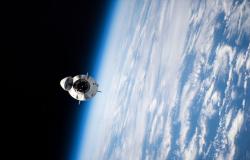NASA is to send a solar sail demonstrator into orbit next week, and there is a good chance that the sail, measuring 860 square feet (80 square meters), will be visible from Earth.
Advanced Composite Solar Sail System (click to enlarge) Pic: NASA
The primary goal of the Advanced Composite Solar Sail System (ACS3) mission is to demonstrate the deployment of a new composite boom made from flexible polymer and carbon fiber materials.
Despite being stiffer than previous designs, the tube-shaped boom can be squashed flat and rolled like a tape measure, according to Keats Wilkie, the mission’s principal investigator at NASA’s Langley Research Center in Hampton, Virginia.
Wilkie said: “Booms have tended to be either heavy and metallic or made of lightweight composite with a bulky design – neither of which work well for today’s small spacecraft.”
However, this approach means that the sail’s booms can be reduced to a small package “while offering all the advantages of composite materials, like less bending and flexing during temperature changes.”
Handy, because the 12U CubeSat built by NanoAvionics is hardly a behemoth.
Assuming the boom works well, the team hopes to test the sail’s performance by angling it to adjust the spacecraft’s orbit.
The ACS3 is a secondary payload on Rocket Lab’s “Beginning Of The Swarm” mission, due to be launched from the company’s Launch Complex 1 on April 24. The primary payload on the mission is NEONSAT-1, an Earth observation satellite with a high- resolution camera designed to monitor natural disasters on the Korean Peninsula. Funded by the South Korean government, NEONSAT-1 is due to be joined by other NEONSAT satellites in 2026 and 2027 to build out a constellation.
ACS3 will operate in a Sun-synchronous orbit, approximately 600 miles (1,000 kilometers) above the Earth. Once in orbit, it will unroll its composite booms, and then, approximately 25 minutes later, the solar sail will deploy. Cameras onboard the spacecraft will monitor the deployment.
According to NASA: “With its large sail, the spacecraft may be visible from Earth if the lighting conditions are just right. Once fully expanded and at the proper orientation, the sail’s reflective material will be as bright as Sirius, the brightest star in the night sky.”
Well, it’s large compared to the NanoAvionics spacecraft bus. At roughly six US parking spots, the sail would be dwarfed by the ISS solar array wings, but should all go well, larger-scale models could be designed and launched.
According to NASA: “This boom design could potentially support future solar sails as large as 5,400 square feet (500 square meters), about the size of a basketball court, and technology resulting from the mission’s success could support sails of up to 21,500 square feet (2,000 square meters) – about half a soccer field.”
“Seven meters of the deployable booms can roll up into a shape that fits in your hand,” said Alan Rhodes, the mission’s lead systems engineer at NASA’s Ames Research Center.
“The hope is that the new technologies verified on this spacecraft will inspire others to use them in ways we haven’t even considered.” ®
Tags: NASA solar sail Siriusly visible orbit Earth Register






